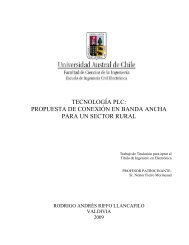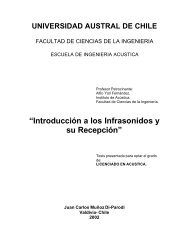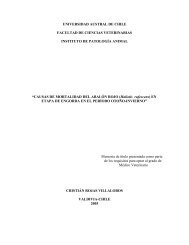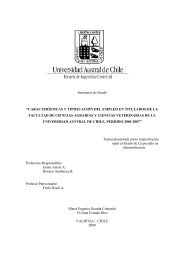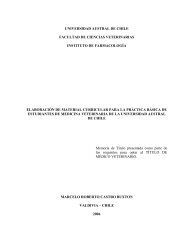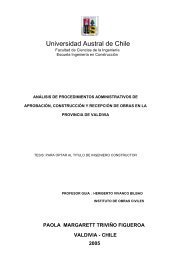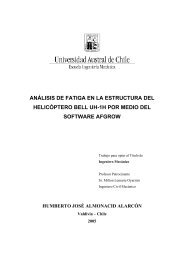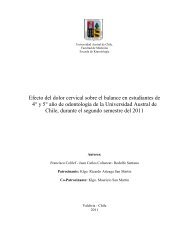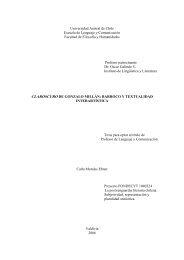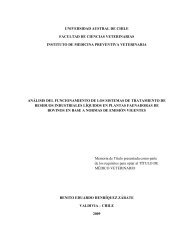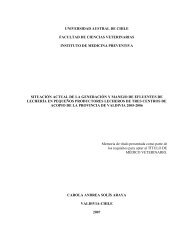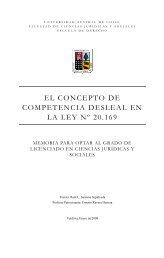Diversidad y control biológico de insectos - CyberTesis UACh ...
Diversidad y control biológico de insectos - CyberTesis UACh ...
Diversidad y control biológico de insectos - CyberTesis UACh ...
You also want an ePaper? Increase the reach of your titles
YUMPU automatically turns print PDFs into web optimized ePapers that Google loves.
Treatments were applied on 15 October 2003, after 18:00 h, with weather conditions of<br />
12.5 (air) and 16.4 (soil) °C, cloudy day with weak showers (rainfall is showed in Figure<br />
1). The pasture was 15-20 cm high. All applications were ma<strong>de</strong> by tractor-mounted sprayer<br />
at 200 L per ha.<br />
Data collection.<br />
Pitfall trapping. Pitfall traps are wi<strong>de</strong>ly used for ground-dwelling arthropod sampling<br />
(Spence and Niemelä, 1994). Because many factors asi<strong>de</strong> from abundance influence pitfall<br />
trap captures, we adopted the term activity-<strong>de</strong>nsity following Thiele (1977) to record and<br />
show our results. Pitfall traps were ma<strong>de</strong> from one 370 mL blank plastic cup (10 cm high, 5<br />
cm diameter), with no cover. The cups had very small holes drilled in the bottom for<br />
drainage. Twelve traps per plot were buried in the soil so that the lip was flush with the soil<br />
surface and arranged on a grid, on 3 columns by 4 rows. The traps were put in the center of<br />
the plot and the grid area was covered by a net to prevent bird foraging on caught<br />
arthropods. The unbaited traps were 0.5 m each other and were active for a 4-days period in<br />
each sampling date. When the traps were not active, they were inverted. The arthropods<br />
were removed from traps every morning. Sampling was performed four times during the<br />
study: before spraying and 1, 30 and 60 days after spraying. Activity-<strong>de</strong>nsity from pitfall<br />
trap captures was shown as the average number of individuals per trap in each 4-d sampling<br />
period.<br />
Soil cores. Thirty soil cores (9 cm diameter, 10 cm high) were extracted at random in each<br />
plot, although they were not extracted close to the plot bor<strong>de</strong>rs to avoid potential edge<br />
effects. The cores were bagged to prevent arthropod escape or loss. Invertebrate were<br />
extracted by Berlese-Tullgren method for 96 h. The cores were put inverted in extractor<br />
over a layer of cheese-cloth over screen of extractor to prevent soil particles being<br />
dislodged into the extractant. A mix of water and a soft <strong>de</strong>tergent were used as extractant.<br />
The content was sifted over a 2 mm mesh screen and then sifted again over a finer mesh<br />
screen. Large specimens were separated by hand or with forks, while the remaining content<br />
was rinsed with tap water over a



